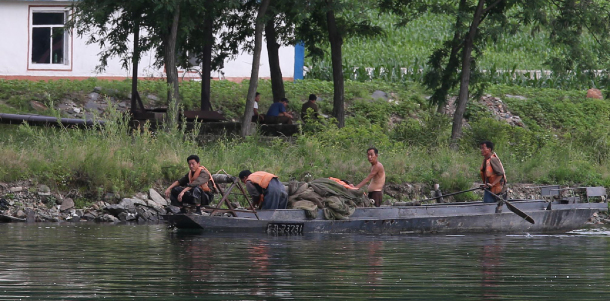North Korea outside of Pyongyang
KIM SU-JEONGThe author is an editorial writer of the JoongAng Ilbo.

North Koreans at a village in North Hamkyeong province are preparing to fish in the Tumen river bordering China. [JOONGANG PHOTO]
Dong-A University professor Kang Dong-wan, director of the Busan Hana Center, which helps North Korean defectors settle in South Korea, recently published “North Korea Outside Pyongyang,” a book about the lives of the North Korean residents near the 1,500-kilometer (932 miles) North Korea-China border. The book has 999 photos.
From last June to August, he spent 40 days in the border region. When he saw North Korean residents while driving around, he stepped out and took photos. His 900-millimeter lens captured young men panning for gold, a young girl braiding her sister’s hair on the river bank, and the tired faces of residents mobilized for “early labor” before going to work and school.
The slogans on the buildings read: “Let’s be true sons and daughters of General Kim Jong-un”; “Shine the revolutionary accomplishments of comrade Kim Jong-suk”; “Hail for General Kim Jong-un, Sun of Juche Joseon.” The anti-American slogans that were supposed to be removed after the summit remained. “Extinguish the American aggressors, our prime enemy!” they read.
It is a time of reconciliation and peace. Kim Jong-un’s determination has reportedly changed North Korea. Last summer, the Blue House said that President Moon Jae-in was reading a book entitled “Time in Pyongyang Flows with Time in Seoul” during his vacation. A former Hankyoreh newspaper photojournalist documented the changes in Pyongyang following his numerous visits to North Korea. Those who argue that North Korea should not be viewed from outdated perspectives recommend this book.
Another developing theory argues that the demonization of North Korea by some Koreans has complicated the Korean Peninsula issue. Former and incumbent ministers, some North Korean defectors supporting the government stance and Korean-American Shin Eun-mi, who was deported a few years ago because of her pro-North Korean concerts, all publicly address the harm of demonizing North Korea.
“In North Korea, there is a Pyongyang resident card other than a regular identification card. Pyongyang is different from other places. Despite a number of summits, it doesn’t change the fact that Kim Jong-un is a dictator and North Koreans live in a gigantic prison. I captured the sights in the border region in my camera. If telling facts is demonizing, what do you call glamorizing the demon?” said professor Kang.










with the Korea JoongAng Daily
To write comments, please log in to one of the accounts.
Standards Board Policy (0/250자)